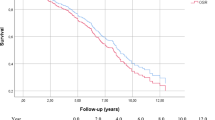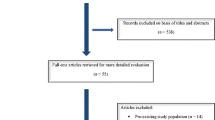Abstract
Objectives
The aim of our study was to evaluate minimally invasive techniques for the treatment of anterior circulation aneurysms versus standard surgery, and to calculate the impact of these techniques on health resources, length of stay, and treatment costs.
Methods
A consecutive series of 24 patients with ruptured and 30 with unruptured anterior circulation aneurysms treated with minimally invasive microsurgery (MIM) by the same surgeon was compared with a matched series of standard microsurgeries (SM) conducted for 23 ruptured and 22 unruptured aneurysms. Complication rates, aneurysm obliteration, modified Rankin Scale (mRS) outcomes, length of stay, and treatment costs were assessed.
Results
Surgical complications, aneurysm obliteration rates and mRS outcomes were comparable between MIM and SM groups in ruptured and unruptured aneurysm cohorts. MIM resulted in shorter operative times both in unruptured (102.7 ± 4.35 vs 194.7 ± 10.26 min, p < 0.0001) and ruptured aneurysms (124.3 ± 827 vs 209 ± 13.84 min, p < 0.0001). Length of stay was reduced in patients with MIM for unruptured aneurysms (1.55 ± 24 vs 4.28 ± 0.71 days, p < 0.000,1) but not in those with ruptured aneurysms. MIM reduced treatment costs of unruptured aneurysm patients, mainly through reduced utilization of inpatient resources (non-acute bed costs in CAD: 371.2 ± 80.99 vs 1440 ± 224.1, p < 0.0001), whereas costs were comparable in patients with ruptured aneurysms.
Conclusion
Minimally invasive surgery is a safe and effective approach for the treatment of ruptured and unruptured aneurysms of the anterior circulation. In patients with unruptured aneurysms, reduced invasiveness and shorter operative times decreased length of stay, which reflects improved patient postoperative recovery. Overall, this translated into bed resource economy and cost reduction.





Similar content being viewed by others
References
Boulton M, Bernstein M (2008) Outpatient brain tumor surgery: innovation in surgical neurooncology. J Neurosurg 108:649–654
Brydon HL, Akil H, Ushewokunze S, Dhir JS, Taha A, Ahmed A (2008) Supraorbital microcraniotomy for acute aneurysmal subarachnoid haemorrhage: results of first 50 cases. Br J Neurosurg 22:40–45
Carrabba G, Venkatraghavan L, Bernstein M (2008) Day surgery awake craniotomy for removing brain tumours: technical note describing a simple protocol. Minim Invasive Neurosurg 51:208–210
Cheng WY, Lee HT, Sun MH, Shen CC (2006) A pterion keyhole approach for the treatment of anterior circulation aneurysms. Minim Invasive Neurosurg 49:257–262
Czirjak S, Nyary I, Futo J, Szeifert GT (2002) Bilateral supraorbital keyhole approach for multiple aneurysms via superciliary skin incisions. Surg Neurol 57:314–323, discussion 323–314
Dare AO, Landi MK, Lopes DK, Grand W (2001) Eyebrow incision for combined orbital osteotomy and supraorbital minicraniotomy: application to aneurysms of the anterior circulation. Technical note. J Neurosurg 95:714–718
Fischer G, Stadie A, Reisch R, Hopf NJ, Fries G, Bocher-Schwarz H, van Lindert E, Ungersbock K, Knosp E, Oertel J, Perneczky A (2011) The keyhole concept in aneurysm surgery: results of the past 20 years. Neurosurgery 68:45–51, discussion 51
Khu KJ, Doglietto F, Radovanovic I, Taleb F, Mendelsohn D, Zadeh G, Bernstein M (2010) Patients’ perceptions of awake and outpatient craniotomy for brain tumor: a qualitative study. J Neurosurg 112:1056–1060
Lan Q, Gong Z, Kang D, Zhang H, Qian Z, Chen J, Huang Q (2006) Microsurgical experience with keyhole operations on intracranial aneurysms. Surg Neurol 66(Suppl 1):S2–S9
Mitchell P, Kerr R, Mendelow AD, Molyneux A (2008) Could late rebleeding overturn the superiority of cranial aneurysm coil embolization over clip ligation seen in the International Subarachnoid Aneurysm Trial? J Neurosurg 108:437–442
Mitchell P, Vindlacheruvu RR, Mahmood K, Ashpole RD, Grivas A, Mendelow AD (2005) Supraorbital eyebrow minicraniotomy for anterior circulation aneurysms. Surg Neurol 63:47–51, discussion 51
Molyneux AJ, Kerr RS, Yu LM, Clarke M, Sneade M, Yarnold JA, Sandercock P (2005) International subarachnoid aneurysm trial (ISAT) of neurosurgical clipping versus endovascular coiling in 2143 patients with ruptured intracranial aneurysms: a randomised comparison of effects on survival, dependency, seizures, rebleeding, subgroups, and aneurysm occlusion. Lancet 366:809–817
Mori K, Osada H, Yamamoto T, Nakao Y, Maeda M (2007) Pterional keyhole approach to middle cerebral artery aneurysms through an outer canthal skin incision. Minim Invasive Neurosurg 50:195–201
Mori K, Yamamoto T, Nakao Y, Oyama K, Esaki T, Watanabe M, Nonaka S, Hara T, Honma K (2008) Lateral supraorbital keyhole approach to clip unruptured anterior communicating artery aneurysms. Minim Invasive Neurosurg 51:292–297
Niemela M, Koivisto T, Kivipelto L, Ishii K, Rinne J, Ronkainen A, Kivisaari R, Shen H, Karatas A, Lehecka M, Frosen J, Piippo A, Jaaskelainen J, Hernesniemi J (2005) Microsurgical clipping of cerebral aneurysms after the ISAT Study. Acta Neurochir Suppl 94:3–6
Paladino J, Mrak G, Miklic P, Jednacak H, Mihaljevic D (2005) The keyhole concept in aneurysm surgery—a comparative study: keyhole versus standard craniotomy. Minim Invasive Neurosurg 48:251–258
Ramos-Zuniga R, Velazquez H, Barajas MA, Lopez R, Sanchez E, Trejo S (2002) Trans-supraorbital approach to supratentorial aneurysms. Neurosurgery 51:125–130, discussion 130–121
Reisch R, Perneczky A (2005) Ten-year experience with the supraorbital subfrontal approach through an eyebrow skin incision. Neurosurgery 57:242–255, discussion 242–255
Reisch R, Perneczky A, Filippi R (2003) Surgical technique of the supraorbital key-hole craniotomy. Surg Neurol 59:223–227
Steiger HJ, Schmid-Elsaesser R, Stummer W, Uhl E (2001) Transorbital keyhole approach to anterior communicating artery aneurysms. Neurosurgery 48:347–351, discussion 351–342
van Lindert E, Perneczky A, Fries G, Pierangeli E (1998) The supraorbital keyhole approach to supratentorial aneurysms: concept and technique. Surg Neurol 49:481–489, discussion 489–490
Warren WL, Grant GA (2009) Transciliary orbitofrontozygomatic approach to lesions of the anterior cranial fossa. Neurosurgery 64:324–329, discussion 329–330
Wiebers DO, Whisnant JP, Huston J 3rd, Meissner I, Brown RD Jr, Piepgras DG, Forbes GS, Thielen K, Nichols D, O’Fallon WM, Peacock J, Jaeger L, Kassell NF, Kongable-Beckman GL, Torner JC (2003) Unruptured intracranial aneurysms: natural history, clinical outcome, and risks of surgical and endovascular treatment. Lancet 362:103–110
Conflict of interest
None.
Author information
Authors and Affiliations
Corresponding author
Rights and permissions
About this article
Cite this article
Radovanovic, I., Abou-Hamden, A., Bacigaluppi, S. et al. A safety, length of stay, and cost analysis of minimally invasive microsurgery for anterior circulation aneurysms. Acta Neurochir 156, 493–503 (2014). https://doi.org/10.1007/s00701-013-1980-x
Received:
Accepted:
Published:
Issue Date:
DOI: https://doi.org/10.1007/s00701-013-1980-x




